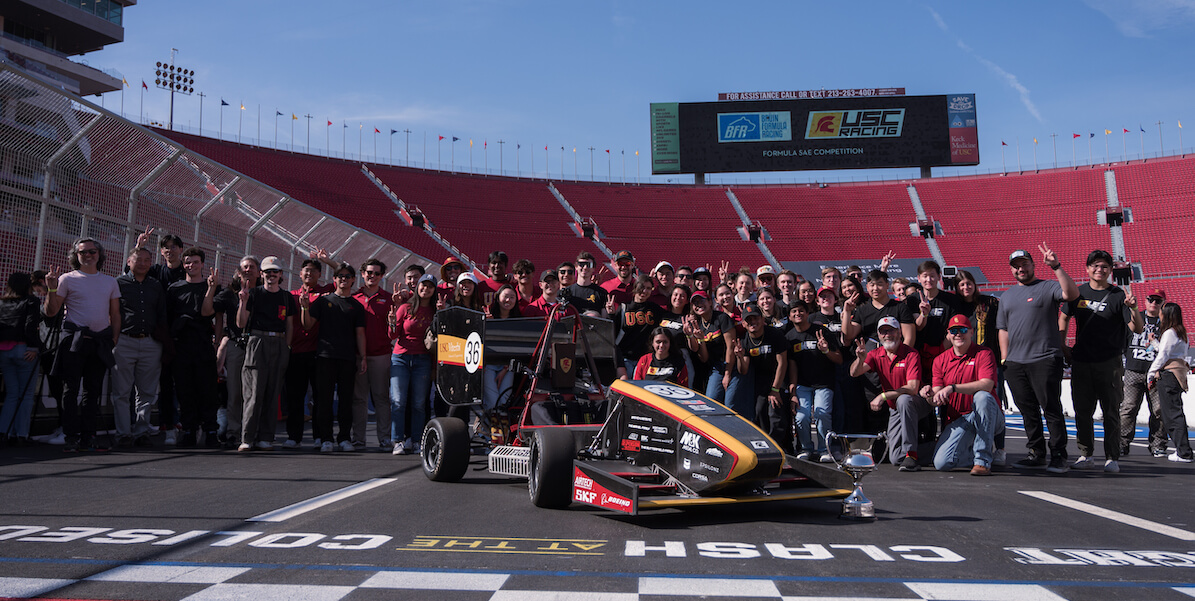
USC Racing student design team compete at the NASCAR Busch Light Clash at the Coliseum
The Busch Light Clash at the Coliseum marked the launch of the NASCAR spring season in Southern California – and this year, NASCAR added some extra spice to the mix.
Saturday Feb. 4, USC Racing trialed their student-designed car alongside UCLA’s Bruin Formula Racing. Once the track was warmed up by the two student teams, NASCAR professionals arrived on the scene to practice and qualify in advance of the Busch Light Clash the following day, setting in motion a weekend-long, fuel-infused spectacle.
“These cars are designed by some of the brightest young minds in engineering and racing, and these students are proof positive that the future of our sport is in great hands,” said Ben Kennedy, NASCAR’s senior vice president for racing development and strategy.
Competition and creativity
Let’s reverse back. What exactly is USC Racing, and how did a student-designed car find its way onto a NASCAR track?
Covering everything from business strategy and communications to engineering and design, USC Racing is the USC’s chapter of Formula SAE – a series of international competitions in which university teams compete to design and manufacture the best performing racecars. Based out of the fully-equipped Baum Family Maker Space, the team has everything they need to design, construct and test autocross racecars, developing a wholly new high-performing vehicle each year. So, when NASCAR first had the idea to temporarily transform the L.A. Coliseum into a motorsports venue in 2022, it made sense to invite USC Racing to test their wheels on the custom quarter-mile track.
Last year’s event was such a success that NASCAR returned with the idea of harnessing the rivalry between USC and UCLA.
“The spirit of competition definitely added an edge to the rigorous process of fine-tuning and testing the car,” said Jiyu (Nick) Qian, president of USC Racing, and a senior in the Department of Aerospace and Mechanical Engineering. “Building a racecar from scratch can be intimidating – it’s a very laborious process. Our team is open to students from any major, even without prior experience in engineering. What we share is a passion for the process and a commitment to creating the very best car we can.”
Racing and recruitment
If you survey the top engineers in global motorsports, they’re likely to have earned their stripes as members of Formula SAE. So, for USC students interested in the industry, joining USC Racing is the first lap of their career track.
That was the case for Amani Ghonim, a senior in the Department of Aerospace and Mechanical Engineering and chief engineer and project manager of USC Racing. When she won an internship at NASCAR after meeting representatives from the organization following the 2022 event, she was invited to help strategize the future clash between the two student teams.
“A lot of companies will recruit directly from the USC Racing team,” said Ghonim. “The internship was a great balance of everything – track tests, traveling for races and design work developing computer models for the aerodynamics team. The whole time I was there, I was constantly recognizing the ways that my academic work matched up with the practical problem solving of a professional setting, and there were so many applications of my USC Racing experience. When we were doing tests in the wind tunnel, we took the car apart and it was great to see that the suspension for the NASCAR vehicle was sequenced in the exact same way as our USC Racing car.”
For Yann Staelens, faculty advisor to USC Racing and associate professor of aerospace and mechanical engineering practice, the conversion from theoretical principles to hands-on experience is central to an engineer’s education. “It doesn’t matter which industry you go into – being part of these student-run design teams shows that you can be a self-starter and apply what you’ve learned in the classroom. The skills you learn while working on the car can be transferred to any engineering field – aerospace, electrical and even to the design of biomedical devices.”
The future of motorsports
Now, it’s back to the Baum Family Maker Space to tune up a new racecar currently in development for the national Formula SAE competition in May. What’s more, the internal combustion engine racecar isn’t the only automobile project in development at the USC Maker Space. There’s also a design team working on an electric car and a solar-powered car – projects that are venturing into wholly new territory, responding to industry needs and rapid advances in emerging technologies.
Who knows what the motorsports events of the future will look, feel, and sound like. But one thing’s for sure. That future is currently being incubated in maker spaces at the world’s top universities. “USC Racing bridges the gap between school work and professional work,” said Qian. “The Clash at the Coliseum was amazing opportunity to demonstrate what our team is capable of, performing alongside the best of the best.”
Published on February 8th, 2023
Last updated on October 2nd, 2024







